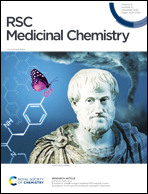Stabilized cyclic peptides as modulators of protein–protein interactions: promising strategies and biological evaluation
Abstract
Protein–protein interactions (PPIs) control many essential biological pathways which are often misregulated in disease. As such, selective PPI modulators are desirable to unravel complex functions of PPIs and thus expand the repertoire of therapeutic targets. However, the large size and relative flatness of PPI interfaces make them challenging molecular targets for conventional drug modalities, rendering most PPIs “undruggable”. Therefore, there is a growing need to discover innovative molecules that are able to modulate crucial PPIs. Peptides are ideal candidates to deliver such therapeutics attributed to their ability to closely mimic structural features of protein interfaces. However, their inherently poor proteolysis resistance and cell permeability inevitably hamper their biomedical applications. The introduction of a constraint (i.e., peptide cyclization) to stabilize peptides' secondary structure is a promising strategy to address this problem as witnessed by the rapid development of cyclic peptide drugs in the past two decades. Here, we comprehensively review the recent progress on stabilized cyclic peptides in targeting challenging PPIs. Technological advancements and emerging chemical approaches for stabilizing active peptide conformations are categorized in terms of α-helix stapling, β-hairpin mimetics and macrocyclization. To discover potent and selective ligands, cyclic peptide library technologies were updated based on genetic, biochemical or synthetic methodologies. Moreover, several advances to improve the permeability and oral bioavailability of biologically active cyclic peptides enable the de novo development of cyclic peptide ligands with pharmacological properties. In summary, the development of cyclic peptide-based PPI modulators carries tremendous promise for the next generation of therapeutic agents to target historically “intractable” PPI systems.



 Please wait while we load your content...
Please wait while we load your content...